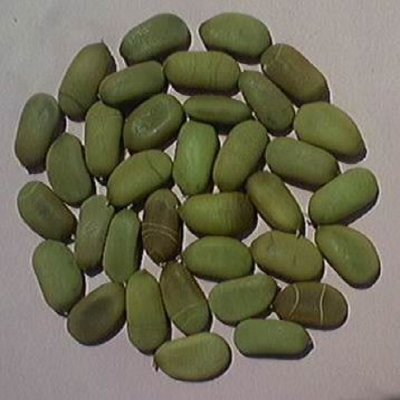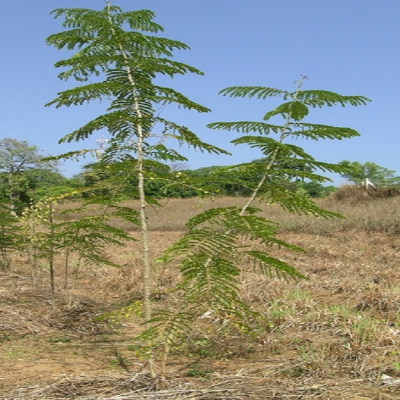Biancaea sappan (L.) Tod.
Synonyms : Caesalpinia sappan L.
Family : Fabaceae
Group : Dyes
Parts Used : Heartwood
Vernacular Names :-
| English | : | Brazil Wood |
| Malayalam | : | Chappangam, pathimukham |
| Hindi | : | Bakam, Patamg |
| Sanskrit | : | Patrangah |
| Bengali | : | Bakam |
| Kannada | : | Patranga |
| Tamil | : | Patungam |
| Telungu | : | Putanga |
Distribution and habitat: It is cultivated in South India and Bengal
Botany: A tree 6-9 m high; stem prickly, 15-25 cm diameter; branches rufous- pubescent, armed with a few small prickles.
- Leaf: 20-38 cm long; pinnate 8-12 pairs, 10-15 cm long, sub-sessile, with small prickles at the base. Leaflets 10-18 pairs, 1.3-2 x 1 cm, sub sessile, close, oblong, rounded at the apex, attached at the lowest corner, very inequilateral, glabrous above, more or less puberulous beneath.
- Flower: Panicle, which are terminal and in the axils of upper leaves, 30-40 cm long; pedicels 1.3-1.5 cm long; bracts lanceolate, 8 mm long, caducous. Calyx 11mm long, leathery, glabrous. Corolla 2 cm across; petals orbicular, sub equal, yellow upper with a red spot at the base. Ovary grey-velvetty.
- Fruit: Pods obliquely, oblong 7.5-10 cm x 3.8-5 cm sized, woody, and sub compressed, polished, and indehiscent, with a hard recurved short beak at the upper angle of the obtuse apex.
- Seed: Yellowish brown, flat oval, 15 mm in diameter
Properties: Anti-cancer, anti-inflammatory, semen coagulating
Chemical constituents:
Heart wood – α-amyrin, aminoacids, β-sitosterol, brasilin essential oil
Leaf- 0.6 to 25% essential oil, α, δ-phellandrene as chief constituents: Oscimine also present.
Pod- Cases and bark –tannin
Uses: Burning sensation, wounds, ulcers, leprosy, skin diseases, diarrhoea, dysentery, diabetes, epilepsy, blood complaints
Agrotechnology:
Soil and climate: Well drained fertile soil. Prefers tropical climate with high rainfall.
Propagation: Seeds
Manures and fertilizers: Apply 10-20 kg Farm Yard manure per plant at the time of planting. FYM may be applied in the subsequent years with the onset of monsoon. NPK fertilizer @60:30:30g/plant helps to improve growth.
Irrigation: 1-2 year old seedlings may be given a weekly irrigation of 30-50 litres during summer months. This should be accompanied by thick mulching.
Plant protection: The insects affecting the plant are stem girdler, stem borer, mealy bugs etc. The stem girdler girdles the bark at about 1-3 feet from ground level of saplings in the age group of 1-3 years. The damage can be prevented and also can be controlled by spraying 0.2% carbaryl on the stem upto 1 m from ground during April-May at fortnightly interval. Stem borer caterpillars bore in to the stem and eat away the stem core. The insect can be easily controlled by spraying 0.2% carbaryl on the stem upto 1 m from ground during April-May at fortnightly interval. At the late stages of infestation, the bore holes may be cleared and a few granules of phorate 10 G may be inserted and the hole closed with mud to kill the insect. Mealy bugs are a sucking pest prevalent during rainy months can be prevented by spraying 0.2% carbaryl on the stem upto 25 cm from ground during April- May at fortnightly interval.
Collar rot is a fungal disease causing severe damage in ill drained soils of high rainfall areas. The bark of the root and the stem in contact with soil gets rotted. The plant top shows symptoms of yellowing followed by withering. Providing sufficient drainage by making channels is the best measure for prevention as well as control. The vulnerable areas, drenching with 1% Bordeaux mixture or 3% mancozeb may be undertaken for prophylaxis. In case the infection is detected early, the affected areas may be exposed by excavation and swabbed with fungicide.
Harvesting: The tree is cut down after 15-20 days years and the heart wood is collected. After harvest the leaves are removed and woody portions with heartwood are collected. The white soft wood from the periphery is shaved off, the wood cut into convenient length and packed for marketing.


